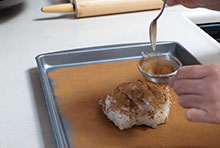
Yatsuhashi
| Ingredient | 9 Yatsuhashi | 9 Yatsuhashi |
|---|---|---|
| shiratamako or mochiko | 1½ oz. | 40g |
| joshinko | 2 oz. | 60g |
| sugar | 2¾ oz. | 80g |
| water | 5 oz. | 150ml |
| cinnamon | 1 Tbsp. | 1 Tbsp. |
| kinako | 1 - 1½ oz. | 30 - 40g |
| koshian | 3 oz. | 90g |
Yatsuhashi are an interesting confection that Kyoto is famed for. Similar to Gyūhi, they are an alluringly soft slice of chewy rice dough coated in cinnamon and sweet soy flour and wrapped around a ball of anko. The mix of strong, familiar spice and subtle, slightly exotic flavors should appeal to those who’ve developed a taste for traditional Japanese confectionery, although they might strike less-attuned palates as a bit odd.
Preparation
- Prepare a batch of anko for the filling; freeze any you don’t end up using.
- Divide the anko into nine equal balls.
 Mix the kinako and cinnamon together. Spread about half of the mixture on a large cutting board or similar work surface; a cookie sheet can be used if you don’t have anything else that will work.
Mix the kinako and cinnamon together. Spread about half of the mixture on a large cutting board or similar work surface; a cookie sheet can be used if you don’t have anything else that will work.
Directions
- Whisk together water and dry ingredients.
Put the shiratamako flour in a microwavable bowl and add water a little at a time, whisking constantly so it doesn’t clump. Once you’ve added enough water that it’s no loger lumpy, you can add the remainder of the water at once and continue whisking until smooth. Add the sugar and joshinko to the dough and whisk until smooth.
If you’re using mochiko, there’s no need to mix the ingredients separately; just combine the mochiko, sugar, and joshinko and add water slowly while whisking, until mixed thoroughly. - Heat and stir.
Loosely cover the top of the bowl with plastic wrap and microwave on high for 50 seconds (for a 1500W microwave; 2 minutes for a 600W microwave). Wet a wooden spoon so it won’t stick and stir the mixture well. Re-cover and microwave for another 20-30 seconds (1 minute for a 600W microwave), until it begins to look less like white dough, and just a bit transparent.

- Mix.
Wet the spoon again and mix until it forms a smooth, stretchy ball. - Roll out.
Dust a rolling pin with the kinako cinnamon mixture. Turn the dough onto the dusted work surface and roll it out while dusting with the remaining mixture. Make a sheet as close to square as you can, about 21cm (8") on each side. It should be well-coated, and quite thin, about 2-3mm thick (a little less than an eighth of an inch).

- Cut into squares and fill.
Cut into 9 equal 7cm (2½") squares. Put a ball of anko onto the center of each square and fold in half into a triangle.
Notes
- This recipe requires several relatively exotic varieties of flour that will require a trip to an Asian specialty market to procure: Joshinko is a top-grade rice flour made from non-glutenous rice. Shiratamako is sweet rice flour. Mochiko is a different type of sweet rice flour, and usually easier to find in supermarkets. Finally, kinako is a flour made from soy beans frequently used in Japanese confections.
- You can adjust the ratio of cinnamon to kinako to taste. You can even omit the kinako entirely, although without it the cinnamon will stick well and the flavor will be quite intense.
- If you prefer chunkier tsubuan to koshian, you can substitute it.

